The market for interactive entertainment has grown multiple fold in the past decade.
One of the prime examples of such applications is fantasy sports apps. People can directly interact with a live game.
The thrill of choosing your team and waiting for their performance makes it super exciting for a user. To take this excitement to the next level, enthusiasts are investing in the latest technologies.
The most popular choice of tech for this has been AR/VR.
Augmented Reality and Virtual Reality have found their way into the realm of fantasy sports apps and offer some cutting-edge features.
In this post let us take a look at what those features are, how they work, and more importantly how AR/VR has transformed the fantasy app industry. So without further ado, let’s begin!
What is AR/VR in Fantasy Sports Apps: Market Size and Their Related Stats
AR/VR in fantasy sports apps offers an immersive experience for users at different stages. You see, fantasy sports apps are all about competitive stats and online contests.
There is no direct media involved to engage the user.
Thanks to these technologies, app owners and developers have found a way to gamify the entire app experience by integrating different immersive features that can be brought to life with the implementation of AR/VR in fantasy sports.
The market has shown great acceptance of AR/VR as it has shown great adaptability.
If we talk about the market for AR/VR it is a growing one as it is expected to grow from $727.44 million to a whopping $5,897.53 million between the years 2024-2032 with a CAGR of 29.90%.
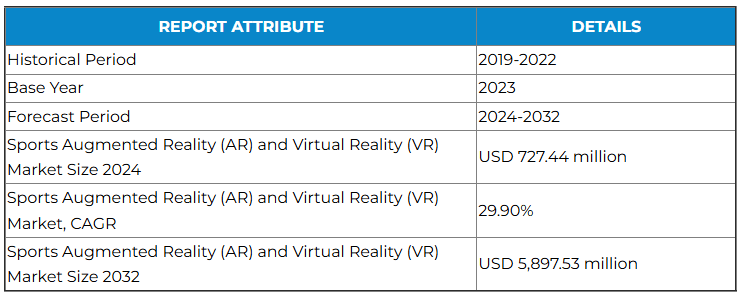
The numbers clearly state that the use of AR/VR is one of the most popular trends in fantasy sports app.
Hence, if you are planning to step into the AR/VR fantasy sports market, then integrating AR/VR can be a great way to attract new users.
Key Features of AR/VR in Fantasy Sports Apps (User, Admin, Advanced)
There are different fantasy sports app features that AR/VR brings along when implemented. In case you are worried about making things work in your app, here are some features that you can consider integrating.
If talk about the categories of features, there are three types that you can find in an AR/VR-enabled fantasy sports application, i.e. User. Admin, & Advanced users.
Let’s take a look at all the features you might find in an AR/VR integrated fantasy sports app –
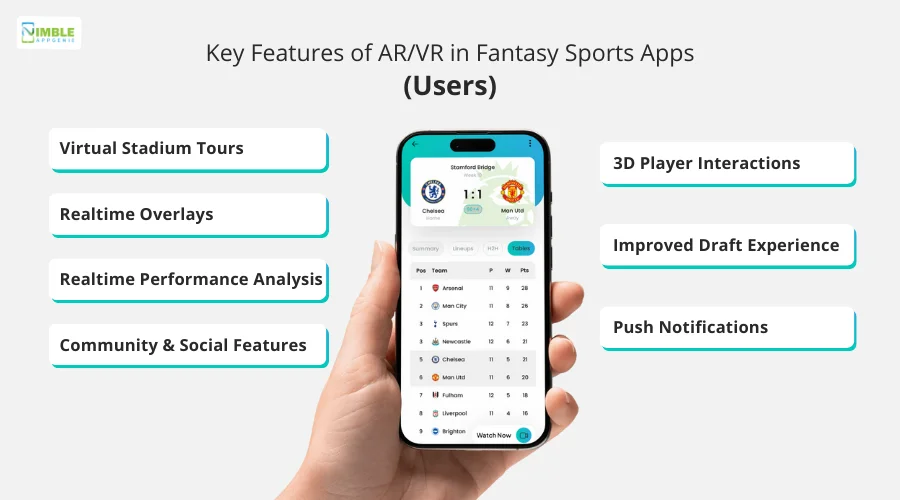
Users:
- Virtual Stadium Tours:
- 3D Player Interactions
- Realtime Overlays
- Improved Draft Experience
- Realtime Performance Analysis
- Push Notifications
- Community & Social Features

Admin:
- User Management Tools
- User Activity Tracking
- Payment Gateways Integration
- Advertising Tools
- Virtual Tour Management
- Match Flow Management Tools
- Virtual Design Tools
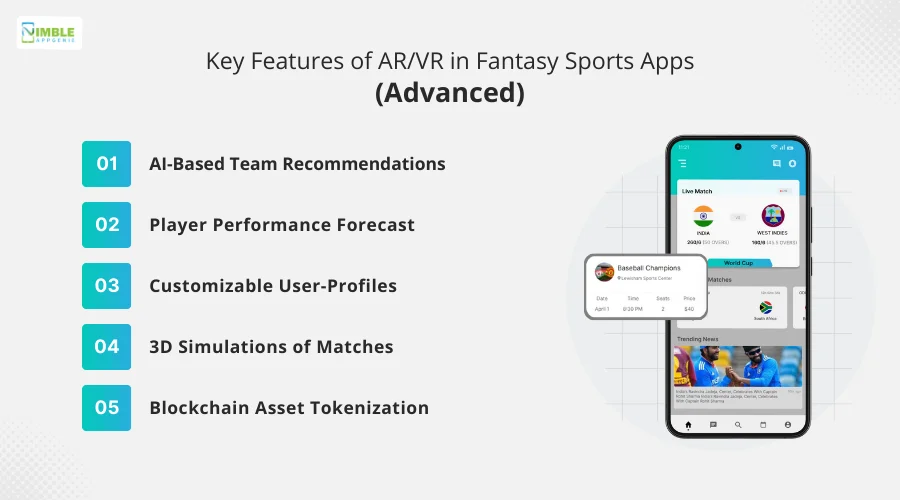
Advanced:
- AI-Based Team Recommendations
- Player Performance Forecast
- Customizable User-Profiles
- 3D Simulations of Matches
- Blockchain Asset Tokenization
The possibilities with technologies like augmented reality and virtual reality are endless as you can always innovate new features.
Making things interactive is the ultimate goal of integrating these features.
How to Integrate AR/VR in Fantasy Sports Apps
Now here is the question of the hour, how do you integrate these services in your fantasy app? The steps to develop a fantasy sports app remain the same.
You research the market, understand the gap, and then introduce a solution. However, the key factor here is to find the user of AR/VR and integrate it intelligently.
Here are the steps that can help you build an AR/VR-enabled fantasy sports application –
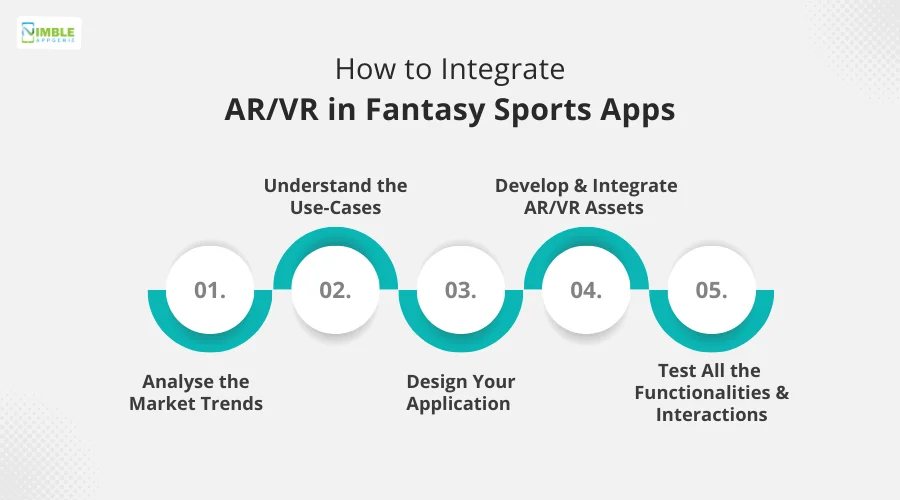
Step 1. Analyse the Market Trends
Before you start building an AR/VR-enabled sports fantasy application, you need to understand the market trends.
These market trends refer to current market practices and what are the features being offered.
This research gives you an idea of how the market perceives the use of Augmented Reality and Virtual Reality in fantasy sports.
Step 2. Understand the Use-Cases
This step allows you to understand the requirements of the app and accordingly, you can opt for the features based on your understanding of use cases.
You see, the majority of the apps integrate these technologies as a gimmick and do not offer a highly useful feature.
If you plan to build an app with AR/VR you would want the user to use the features you offer and hence understanding the use case is crucial.
Step 3. Design Your Application
Having a dedicated place for AR/VR features in your fantasy sports application is crucial in terms of fantasy sports app design and development.
In this step, you need to design your application in such a way that people can easily interact with the app, without having to go through complex steps.
The navigation, choice of core features, and placement of these features.
Step 4. Develop & Integrate AR/VR Assets
Now that you have a design, a bunch of features, and an understanding of the market, you should start developing the application.
This is the step where you start building your AR/VR assets that you integrate along with the fantasy sports app tech stack. Build functionalities and start integrating them one by one to ensure that the application works fine.
Step 5. Test All the Functionalities & Interactions
Once you are done developing the functionalities it is time to check them all and ensure that they are working fine.
Especially when you have AR/VR services integrated, you must check all the interactions and experience the AR/VR features to check that they work as intended.
After you are done testing all the test cases and are 100% satisfied with the outcome, it is time to launch the application.
Keep in mind that this launch can go either way as you have tested the app in a certain environment and not every user will be able to replicate the same.
Hence you should continuously monitor the performance of your application while paying attention to the feedback you receive.
AR/VR in Fantasy Sports Apps Implementation Challenges & Solutions
While integrating AR/VR is a great solution for your fantasy sports app business, there are a few challenges that you might come across. Usually, managing the cost to develop a fantasy sports app is the biggest of the challenges.
For the majority of app owners and developers these challenges become the dealbreaker.
Check them out and decide for yourself if they bother you –
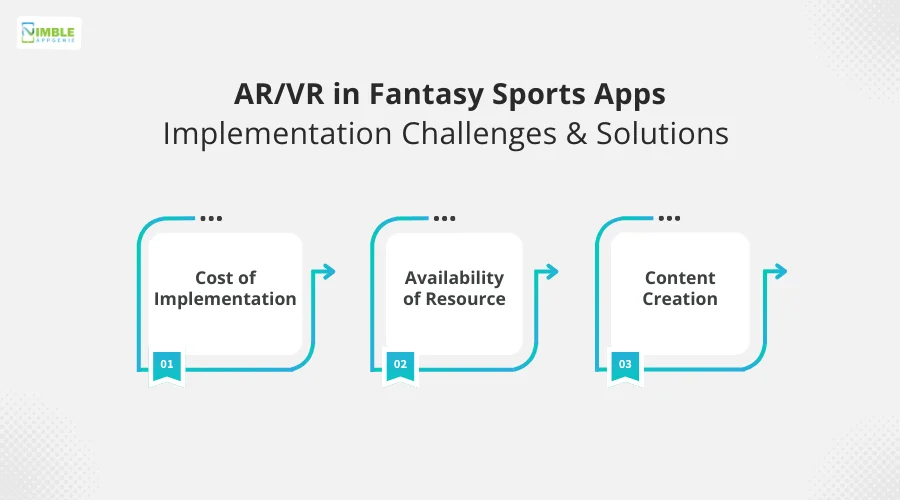
► Cost of Implementation
The very first issue that usually bothers a fantasy app developer is the budget constraint.
Augmented reality and virtual reality are two technologies that require you to spend more than usual on fantasy development, which is often an issue for people starting their business with a cap on their budget.
Solution: The ideal way to handle your implementation cost is to identify the key features you want to integrate into your fantasy sports app and accordingly allocate the budget.
The more you plan, the better your cost of implementation.
► Availability of Resource
You need high-performance computing resources, a larger team of developers and AR/VR specialists, more time, and many other resources.
These resources are high in cost and limited in terms of availability when compared to basic fantasy app development.
The availability-to-cost ratio also varies with the type of team you hire and their location. Finding the right resources under a budget is certainly a challenge many face.
Solution: It might take you some time to fix the final team but you should consider checking multiple resources before finalising one.
Digital resources are surely something that you cannot compromise on; however, you can always make the best decision while choosing the team from a third-party provider to whom you can easily outsource.
► Content Creation
While integrating AR/VR into your application, you need to understand that there will be additional content that you will have to generate purely for AR/VR functionalities.
Generally, fantasy sports apps use a straightforward approach when it comes to sharing content on the app, however when there is AR/VR integrated, content has to be built as per the use.
It is not easy for a user to create content for AR/VR and hence it poses a rigid challenge.
Solution: Content for AR/VR is specially designed for an immersive experience. There are several libraries that offer templates to get started with your application.
You can reduce your complications by getting inspired and get hold on ways to build AR/VR friendly content.
Other than these challenges, one of the most common challenges that people come across is the challenge of education.
You see, there’s no point in introducing new features and tech if the users you are targeting are not equipped to use them. Hence, you have to educate your users about ways to use these.
If all these challenges are too much to handle, you should start looking for a development partner to guide you and help you identify fantasy sports app development mistakes to avoid at any cost.
These challenges can be managed with the right approach by the development team and the experts you hire.
Successful Examples of AR/VR in Fantasy Sports Apps
It is not necessary that these challenges make it difficult to survive and thrive in the industry.
Several active apps have achieved immense success with the implementation of AR/VR in the fantasy sports app business.
Let’s take a look at some of the best fantasy sports apps that have already made it big in the fantasy sports realm by integrating AR/VR.

♦ FanDuel
One of the most popular fantasy sports apps, FanDuel offers real-time player stats with AR overlays and VR-based game simulation.
The app has certainly set the standard for fantasy sports applications as it has millions of users across the world.
Read Also: How To Develop An App Like Fanduel
♦ DraftKings
Another popular app like Draftkings fantasy sports that has left a mark in the fantasy world, DraftKings has started integrating AR/VR in the form of overlays and draft experiences.
♦ ESPN Fantasy Football
Integrating AR/VR with a pinch of AI & ML, ESPN fantasy football offers the best of both worlds with an immersive experience using Virtual Reality and personalized stats and projections based on AI algorithms.
While these apps today focus mainly on traditional fantasy sports, all of them have started integrating the future trends of AR/VR into their apps in one way or another.
You can find glimpses in the form of overlays, stadium views, and more.
Releted Blog: How To Develop An App Like ESPN Fantasy Sports
Future Trends in AR/VR for Fantasy Sports Apps
The use of AR/VR itself emerged as a trend in the growth of fantasy sports applications.
If we go further deep into how the use of AR/VR will change over the coming years, there are significant trends that will drastically improve the experience of users.
Here are some future trends in AR/VR –
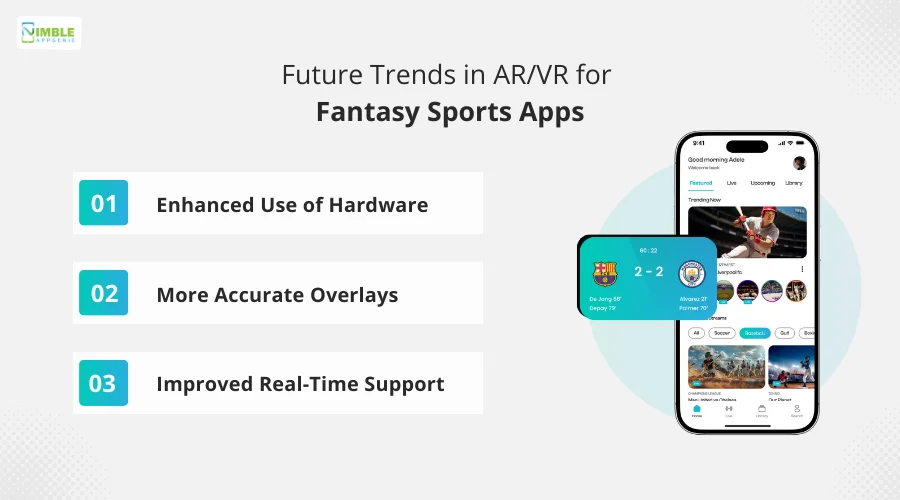
➤ Enhanced Use of Hardware
With virtual reality and augmented reality taking over the experience of a user, there will be a lot of dedicated hardware that will be required.
AR/VR devices such as glasses, headsets, etc. will start making their way into fantasy sports app interactions.
➤ More Accurate Overlays
Today if we take a look at virtual overlays they often seem laggy and inaccurate, there is a lag in updating from player to player.
In the upcoming years, these overlays will become more stable with the use of AI and ML in fantasy sports apps which help in improving virtual reality implementation along with optimized technologies.
➤ Improved Real-Time Support
One of the core reasons why people are hesitant to integrate AR/VR into the application is the lack of real-time support when things go south.
However, with the improvement in technology and implementation of AR/VR in fantasy sports apps, these can certainly improve real-time support.
These trends make the future of AR/VR in fantasy sports apps promising.
If you plan to integrate augmented reality and virtual reality into your business, you must focus on these trends as they will define the upcoming generation of fantasy sports applications.
Leverage AR/VR to Transform Your Fantasy Sports App With Nimble AppGenie
The idea of integrating AR and VR into a fantasy sports app emerged as a way to make data and statistics-oriented games more and more engaging.
At the end of the day, AR/VR are technologies that are used to enhance the experience of users to leverage these features and transform them into a game-changing factor for your fantasy sports app, you need an app development partner.
Nimble AppGenie offers the best fantasy sports app development services that not only help you build a unique experience but also help you take your business to the next level with robust solutions.
Let the experts of our team help you design a perfectly balanced fantasy sports application for your next entrepreneurial adventure. Reach out today!
Conclusion
Understanding the role of AR/VR in fantasy sports apps is highly crucial for people who are associated with the field or are planning to penetrate the realm.
You must understand that these technologies are highly interactive and can be used to create immersive experiences.
Integrating AR/VR has completely refreshed the way people interact with fantasy sports applications.
Improvements in the overall experience of fantasy sports applications mean a widely growing user base and a solid stable career path.
Hence you can always rely on fantasy app developer experts to assist you through.
Hopefully this post gives you all the necessary insights on the role that AR/VR plays in fantasy sports applications. That will be all for this one, thanks for reading! Good luck.
FAQs

Niketan Sharma is the CTO of Nimble AppGenie, a prominent website and mobile app development company in the USA that is delivering excellence with a commitment to boosting business growth & maximizing customer satisfaction. He is a highly motivated individual who helps SMEs and startups grow in this dynamic market with the latest technology and innovation.
Table of Contents





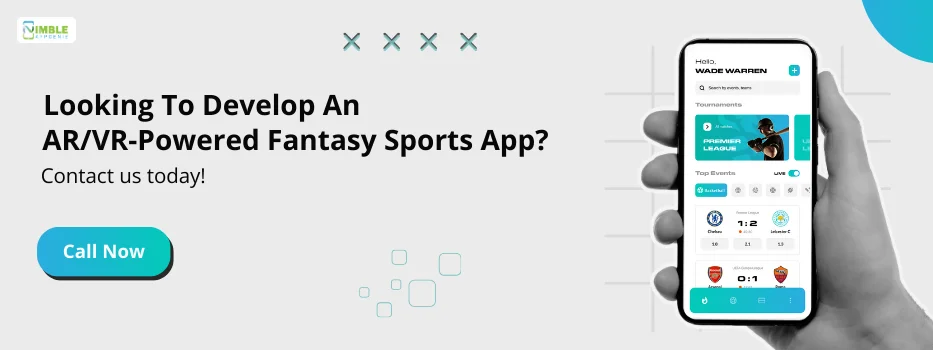
No Comments
Comments are closed.